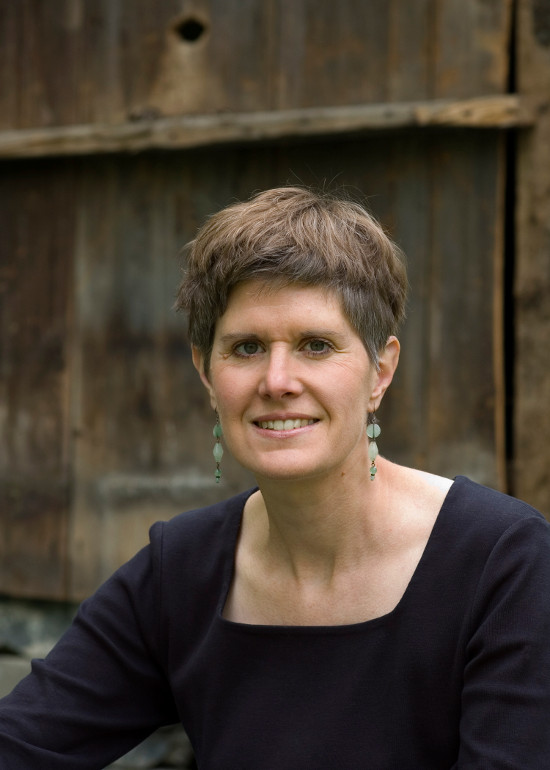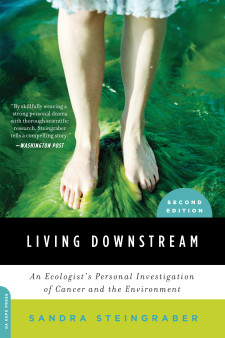
Sandra Steingraber has bachelor and doctorate degrees in biology and a master's in creative writing. "I had long been a biologist by day and poet by night," she said in a phone interview earlier this month. "I kind of kept my writing world and my science world separate."
And that was her intention when she set out to write the book that would become Living Downstream. "It was going to represent my best attempt as a biologist to summarize the links between cancer and the environment," she said.
But the poet in her ended up transforming the project into something unusual: a deeply personal story intertwined with a scientific one, as Steingraber discusses her own cancer in the context of the troubling relationship between chemical pollution and the disease. The hook of the book, she said, is "the life behind one of the data points in the cancer registry, namely my own."
Steingraber will be speaking at St. Ambrose University on October 22 as part of the school's Sustainability Project, which includes events throughout the academic year. Her lecture, she said, will apply the "conceptual theme" of Living Downstream (originally published in 1997, with a second edition and film adaptation released in 2010) to fracking - induced hydraulic fracturing to extract natural gas and petroleum.
She described fracking as "turning the land inside-out for more fossil-fuel extraction" and called it "the biggest emergent environmental threat to public health in the United States right now."
Fracking, she said, uses known carcinogenic chemicals, and it releases benzene - a naturally occurring substance that also causes human cancer.
Defenders of fracking claim that its chemicals remain deep in the earth, but Steingraber noted that drilling creates a pathway to the surface lined with cement, and "cement is not an immortal substance."
It's too early to say with certainty that fracking causes public-health problems, but that's missing the point of Living Downstream. Fracking fits neatly into the book's argument against the status-quo regulatory premise that chemicals - or processes that use them - are safe until proved otherwise.
"What I conclude in Living Downstream - and it came as a surprise to me when I began my investigation, and it still comes as a surprise to my readers - is that this assumption that we have that chemicals are actually tested for safety before they're allowed to be marketed and sold is untrue. In fact, only about 2 percent of chemicals now on the market - many of which we have very intimate contact with - have ever been tested for safety.
"And then you might think: Of that 2 percent, surely if a substance has been demonstrated to be a known carcinogen - meaning we know it causes human cancer ... - we would outlaw such a chemical. And those that may be probable or likely carcinogens, for which we have emerging evidence if not yet exact proof, we wouldn't just keep exposing people, contaminating them without their consent and then waiting 20 or 30 years to find out if it really is a carcinogen. Surely we would compel an industry to demonstrate safety before we would allow these things on the market.
"And it turns out that all those assumptions are wrong."
Permitting fracking, Steingraber said, "is tantamount to running an uncontrolled human experiment on American people. ... There is no ... factory wall here. Fracking occurs right in our communities, right on our farmland. ... Our land is the factory floor. ... There's been no demonstration that this is safe for people."
Steingraber advocates a different regulatory approach: the precautionary principle - the assumption for policy purposes that the use of toxic chemicals is potentially dangerous and needs to be proved safe before being allowed.
"I see this as a violation of our human rights, the idea that none of us agreed to let our bodies be used as the repository for chemicals that are either known to be dangerous or have never been shown to be safe," she said. "So with the burden of proof being on the public to demonstrate by our dying or our sicknesses that we have a problem, we're actually violating people's rights to be healthy and safe and so on."
With fracking, she said, "the only moral thing to do is hit the pause button here. You can't just keep on exposing people and create an experiment for public-health researchers to come and study for 20 years. ... Even if we stopped everything now, we'd have all kinds of great study sites to go in and look at the damage."
"Dig Here"
 Steingraber only needs to look at her body to see the damage caused by this permissive regulatory environment. She grew up in Pekin, Illinois - "I'm kind of coming home," she said of her Quad Cities appearance - and was diagnosed with bladder cancer at age 20.
Steingraber only needs to look at her body to see the damage caused by this permissive regulatory environment. She grew up in Pekin, Illinois - "I'm kind of coming home," she said of her Quad Cities appearance - and was diagnosed with bladder cancer at age 20.
"Questions by my own diagnosing physician in 1979 led me to believe that my cancer was probably caused by an environmental exposure during my childhood ... ," she said. "He asked: Had I ever vulcanized tires? Did I live next to an aluminum smelter? ... I actually did live next to an aluminum smelter, as well as 29 different other industries that I lived just downwind from."
The starting point of Living Downstream was comparing information from state cancer registries (started in the 1970s) and the EPA's Toxic Release Inventory (started in 1986). By the 1990s, Steingraber said, there was enough information to see cancer trends. You could, for example, see a correlation between pesticide spraying in Cape Cod and cancer incidence there. "You can actually map the sort of moving shadow of cancer ... ," she said.
That sort of linking, she said, had "been done in a couple of the highly technical documents. [But] no one had tried to do it for the general public" before Living Downstream.
"I actually returned ... to my hometown, moved into my sister's basement, and began an intensive study of the toxic-waste sites, and water contamination, and the air pollution in my home community and discovered I was just one data point in a cluster of cancers there. That's the story that I tell in Living Downstream."
Through that process, she said, she found support for her belief that her cancer had environmental causes: "One of the things that I discovered was the presence of perchlorethylene, which is dry-cleaning solvent, in my hometown drinking-water wells. Perchlorethylene is a probable bladder carcinogen. So it is likely that my own cancer was caused because ... years before I was born, when machine shops used perchlorethylene as a solvent to de-grease metal parts, somebody dumped a vat of it out back, it seeped into the groundwater, and then I, as a kid, grew up drinking it and paid the price for it. And still am paying the price. Because I am now 54, and I've lived for 34 years as a bladder-cancer patient. I live a highly medicalized life."
It's critical to understand that, by themselves, the links Steingraber uncovered demonstrate correlation rather than causation. "It's not proof of anything," she said. "It's like a red flag that says, 'Dig here.' ...
"Living Downstream is like a big jigsaw puzzle," she explained. If there appears to be a relationship between a toxic release and a cancer cluster, then it's imperative to see what els is known. For example, researchers interested in the link between non-Hodgkin lymphoma and pesticides can explore the scientific literature on malignant lymphoma in dogs, occupational risks for non-Hodgkin lymphoma, and the molecular connection between pesticides and the disease.
"You start to see a picture that emerges," Steingraber said. "I advocate for taking a weight-of-the-evidence approach. So it's not about, 'Okay we have a correlation, so therefore let's ban everything.' ... That [correlation] gives us a duty to inquire further ... and see what else might be there."
But building her case was only part of Steingraber's goal. It was also important to present the scientific information in a way that was compelling to a general audience. That's where her creative-writing master's came into play.
She said she asked herself: "What would it be like to write a book in which I went back and forth between my own personal story ... and then juxtaposed it with the actual science? It occurred to me that that would keep my readers turning the pages," instead of a "dry review" that would only find an audience in the scientific community.
"I wanted to lay the evidence before the public, but I needed to find a vehicle to do it where the public would actually read it," she said. "I felt like if I took the science and strapped it to the hood of a really good personal story, it would make a bigger splash."
Sandra Steingraber will speak at 7 p.m. on Tuesday, October 22, at St. Ambrose University's Galvin Fine Arts Center (518 West Locust Street, Davenport).
For more information on Sandra Steingraber, visit Steingraber.com.








